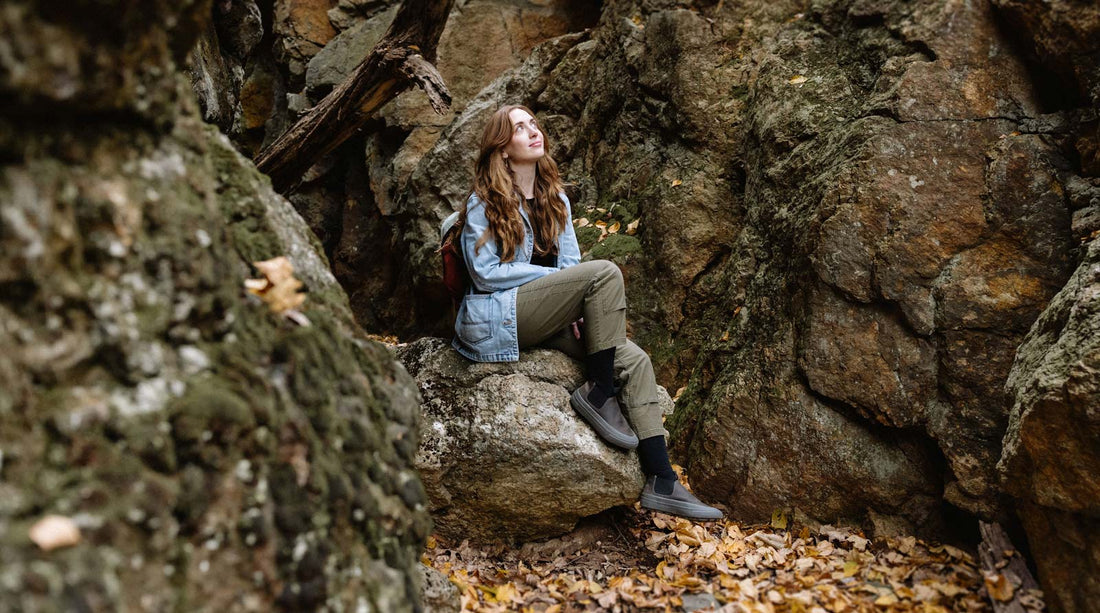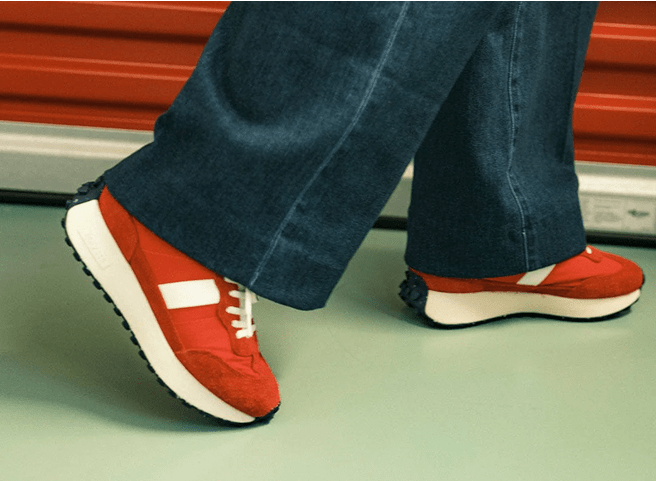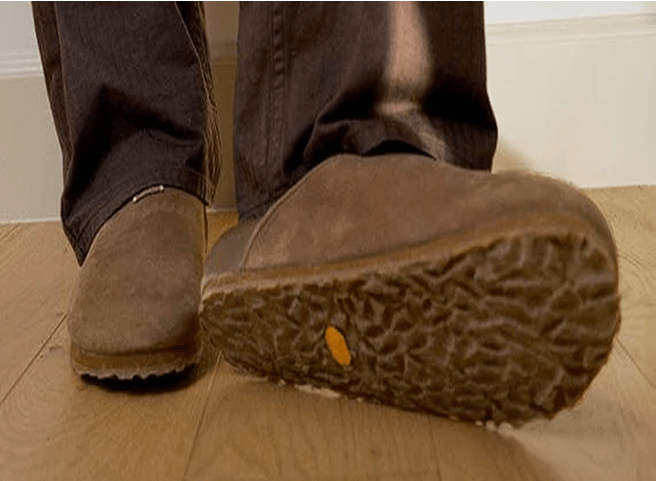Daydreamer Series: Making The Pivot Toward Your Dream
How geologist Becky Nesel took her curiosity and channeled it into a career.

“I think it’s right up here,” says Becky Nesel, studying her phone screen closely before gesturing toward the steep, leaf-strewn trail that climbs the hill in front of her. She smirks and hikes her backpack up her shoulder. “I looked it up, and I’m 99-percent sure it’s not illegal to be here.”
We’re looking for signs of an old Civil War-era mine that was abandoned in the 1870s. As a geologist, Becky is used to following tree blazes and vague directions to strike geologic gold — or, in this case, iron ore. “Oh my gosh,” she exclaims, disappearing over a stack of boulders before popping back up excitedly. “We found it! This is so cool!” We descend into the mine’s chamber, a muddy cavern some 20 feet high and filled with ethereal shafts of light and turquoise water. It’s almost otherworldly, which makes it hard to remember we’re in the middle of a state park in New York’s Hudson Valley.
“It’s that sense of wonder about familiar places I’m always trying to share with people,” she explains, scraping a lump of gelatinous earth from her boot. Whether she’s leading geology walks at her local park, sharing free resources on Youtube, Instagram, and Tiktok, or producing and hosting her HUDSY original television series, New York ROCKS with Geo Beck, the science communicator’s dream is to make discovery a way of life—and not just for her viewers.
As told to SeaVees. Photography by Johnie Gall.


“When I was a kid, I’d spend hours leafing through this mineral guidebook we had. Then I’d go outside with my family and I’d collect rocks the whole time. My mom would go to wash my jacket and find a bunch of stones in the pockets and she’d have to sneak them back outside because if I caught her I’d start crying [laughs]. I had this pull toward rocks and wanted to touch them. I think so many of us have that innate curiosity as children before we’re directed toward the things we’re ‘supposed’ to be interested in. We stop focusing on what excites our spirits.
“I couldn’t picture myself doing that work for the next 40 years, let alone the next five.”
I actually went to school for international studies, but once I enrolled in the classes and was about to buy the textbooks, I started to absolutely panic because I realized it was not for me. I looked at the list of majors available and saw geology. I literally switched my major the night before school started [laughs]. Taking that first class, it felt like an entire universe opened and I just knew I’d be happy and fulfilled once I got my title of ‘geologist’ after college. But once I graduated and went to work in the construction and engineering industry, that dream totally fizzled out. I couldn’t picture myself doing that work for the next 40 years, let alone the next five. All the sudden I’m looking down the barrel of life like, ‘Now what do I do?’ and it scared the absolute crap out of me.


I was really struggling with my mental health at the time. I’d just moved with my boyfriend into our first apartment. We got a cat. That part of my life was going so well but then I’d get to work and feel like something was just…wrong. During my drive into New York City at 5am, I started listening to the science podcast Ologies, and as I learned these wild facts about topics I knew nothing about, there was an explosion of excitement and curiosity inside of me again. You know that urge you have when you learn something new and you just have to share it? I wanted more of that.


When COVID started, I was unemployed and wanted to feel a sense of wonder about geology again, so I made a Youtube video called something like “the reasons I love geology.” I love talking about building stones. In New York City, for example, the Statue of Liberty sits on a pedestal that’s made from beautiful pink granite from Connecticut that’s 700-million years old. Facts like that are how you get people to see that geology isn’t this random thing; these ancient stones from our planet’s past are part of our everyday lives. I became obsessed with learning, with incorporating botany or history, travel or biology into my videos, and they slowly changed from covering concrete topics I already knew about to things I wanted to learn about myself.
“I started to accept that my job is to spark curiosity about a topic and not necessarily give someone a comprehensive course in it.”
I started looking into jobs where I could keep doing what I was doing and I realized science communication was an actual career path—and a really important one at that. When you’re a scientist, you may know everything there is to know about your field but not have the skills to communicate it to people. That’s where writers, speakers, and filmmakers and animators come in and take complicated language in these oftentimes inaccessible academic papers and translate it in a way that not only educates people, but helps them relate to it. Because it’s not that most of us don’t want to learn, you know? We just have limited time and can’t spend all day reading papers. Science communicators provide a bridge.


I started calling myself a science communicator, and that title has a really expansive definition. Doubt started creeping in almost immediately, like, ‘Can I really call myself that if I’m not translating scientific papers?’ I was also worried other scientists would start criticizing my videos. But as I put more videos out, I started to accept that my job is to spark curiosity about a topic and not necessarily give someone a comprehensive course in it. I love that science communication is an emerging career path that leaves space for people to show up as creative humans with expansive skills and interests outside of just science.
“My mission statement has become about showing people they can surprise themselves because I’ve surprised myself so many times.”
The production of my videos would probably make you laugh. It’s just me and my digital camera or my phone. Sometimes I get help from my boyfriend, friends, or my mom, but mostly it’s just me running back and forth because my tripod fell over or I need a new angle [laughs]. I make my own little animations in Procreate. It’s a love-hate relationship because I feel like my passion comes out when I’m producing my own Youtube videos, but I do really love working with a crew and having help making my TV series. It’s something I didn’t think I would be good at, but I’m actually really good at it—that could come off as vain but there’s power in knowing that I’m sharing a passion. My mission statement has become about showing people they can surprise themselves because I’ve surprised myself so many times.

I started therapy and medication in the past few years, which has been amazing. As a neurodivergent person with ADHD and OCD, there’s there’s a lot of stuff going on in my head at all times. It can feel impossible to be creative when you’re dealing with heavy things like that, and working for myself has been a huge challenge. I’m just now starting to make an actual full-time income with this work. Up until December I was working part-time at a bulk refill and sustainability center in my hometown, but I knew I wanted to go after this dream. I had to take the leap and know I could catch myself. The biggest struggle for me has been fighting against a feeling of anxiety that comes with inconsistent income. It’s learning how to parse out a larger payment to cover my expenses during times when things are less fruitful, which I wish more people were honest about.


My advice is to just start making things, even if they’re really bad and cringey. It’s hard, I know! I look back at my first videos and cringe so hard because I think they’re so bad, but I try to watch them with a sense of pride because I took a risk and I grew from that. Dreaming is great, but taking small, baby-sized steps toward your goal is how you actually get there. If you don’t start moving before you’re ‘ready,’ then dreams will stay dreams. And remember to keep checking in with yourself to see if that dream is still bringing you joy and excitement, because when you find something you love, you don’t necessarily have to make it your job.
“If you don’t start moving before you’re ‘ready,’ then dreams will stay dreams.”
With my work, I have been able to feel seen in a way that represents my sparkly childlike curiosity about life. I firmly believe every human has that, and maybe for some of us it’s just buried a little deeper. My dream for everyone is to find that feeling and then to be seen for it.”
Becky wears the Ballard Boot in Charcoal and the Cascade Range Boot in Cashew/Olive.


